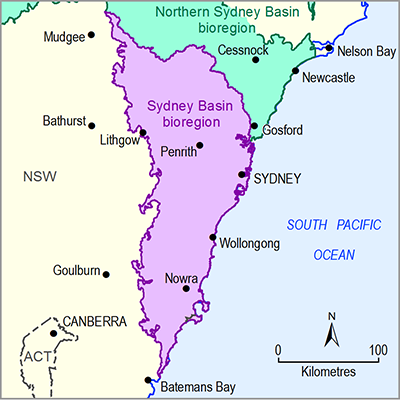Groundwater quality within the Hawkesbury Sandstone varies from fresh to slightly saline and from slightly acidic to slightly alkaline, and is high in iron (SCA, 2005). Water quality within the upper sections of the Hawkesbury Sandstone is often poorer than the lower sections due to leakage from the overlying shale formations. Possible upward flow or migration of brackish to saline groundwater along fractures from underlying Narrabeen Group aquifers or Permian coal measures may be contributing to brackish conditions in the deeper Hawkesbury Sandstone on the eastern side of the Lapstone Structural Complex (Russell et al., 2009). In areas around Camden, the sandstone groundwater is commonly acidic with some pH values recorded below 5 (AGL, 2013).
A centrally-located accumulation of saline water (exceeding 3000 mg/L TDS) exists beneath the Cumberland Basin (Figure 27 of Section 1.1. 3), corresponding to a pattern where groundwater flows radially from elevated recharge areas around the fringes of the downwarped region and is constrained by limited discharge locations (Russell et al., 2009).
Analyses of water quality in an oil and gas exploration bore located to the north of the Wallacia investigation area (south-western Sydney, Figure 31) show that salinity increases with depth in the Narrabeen Group and Illawarra Coal Measures (Parsons Brinckerhoff, 2009).
Groundwater salinity of Triassic age shale units (Wianamatta Group) in the Southern Highlands is generally considerably less (typically <3000 mg/L) than that in the Sydney area (mainly >5000 mg/L). This is attributed to the higher elevation of the former, caused by regional and intermediate deformation and uplift, which contributes to greater flushing of accumulated salts from the rock matrix (Russell et al., 2009).
The Ashfield and Bringelly shales (Late Triassic Wianamatta Group), though primarily aquitards, do include scattered zones of fracture porosity within the weathered bedrock and groundwater is generally saline, typically in the range of 5,000 to 50,000 mg/L (McNally, 2009). The Ashfield and Bringelly Shales are associated with surface salting in parts of western Sydney. At some locations, where the Ashfield Shale overlies or is immediately up gradient of the Hawkesbury Sandstone, saline groundwater from this aquitard contributes to the higher salinities observed in the upper part of the sandstone (Webb et al., 2009). At the same time, upward flow and migration of brackish/saline groundwater from the underlying Narrabeen Group may be contributing to brackish conditions of the deeper Hawkesbury Sandstone on the eastern side of the Lapstone Structural Complex (Webb et al., 2009). This mechanism supports the conceptual model explaining the origin and migration of saline groundwater proposed by Green et al. (2009) and McLean and Ross (2009), and disputes that proposed by McNally (2004, 2009).
The regolith aquifers in the western Sydney area have groundwater with generally low salinities (<1000 mg/L), particularly following heavy rainfall when the salinity can be similar to that in the nearby semi-perennial streams (McNally, 2009).
Groundwater quality of the coal seams in the Illawarra Coal Measures is generally poor, with moderately saline groundwater, mostly between 5,000 and 10,000 mg/L (AGL, 2013).

